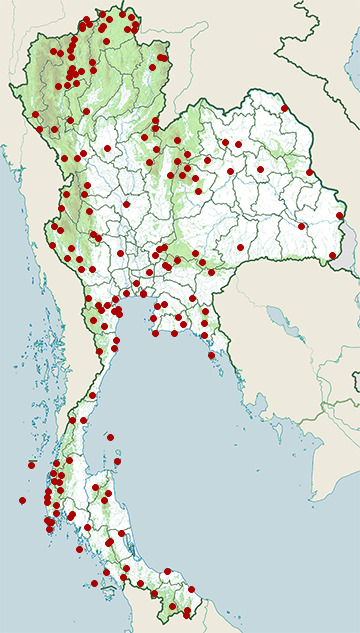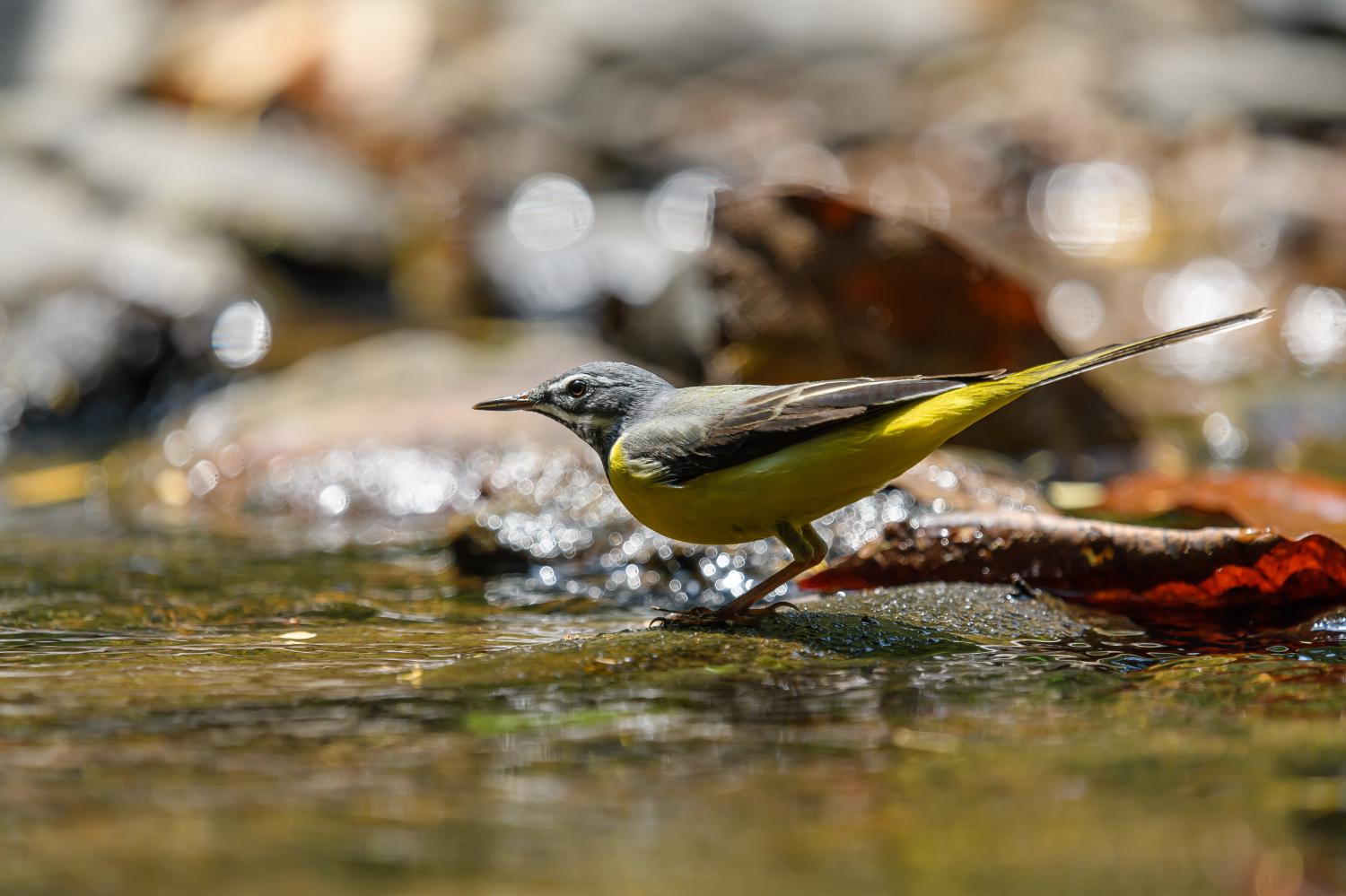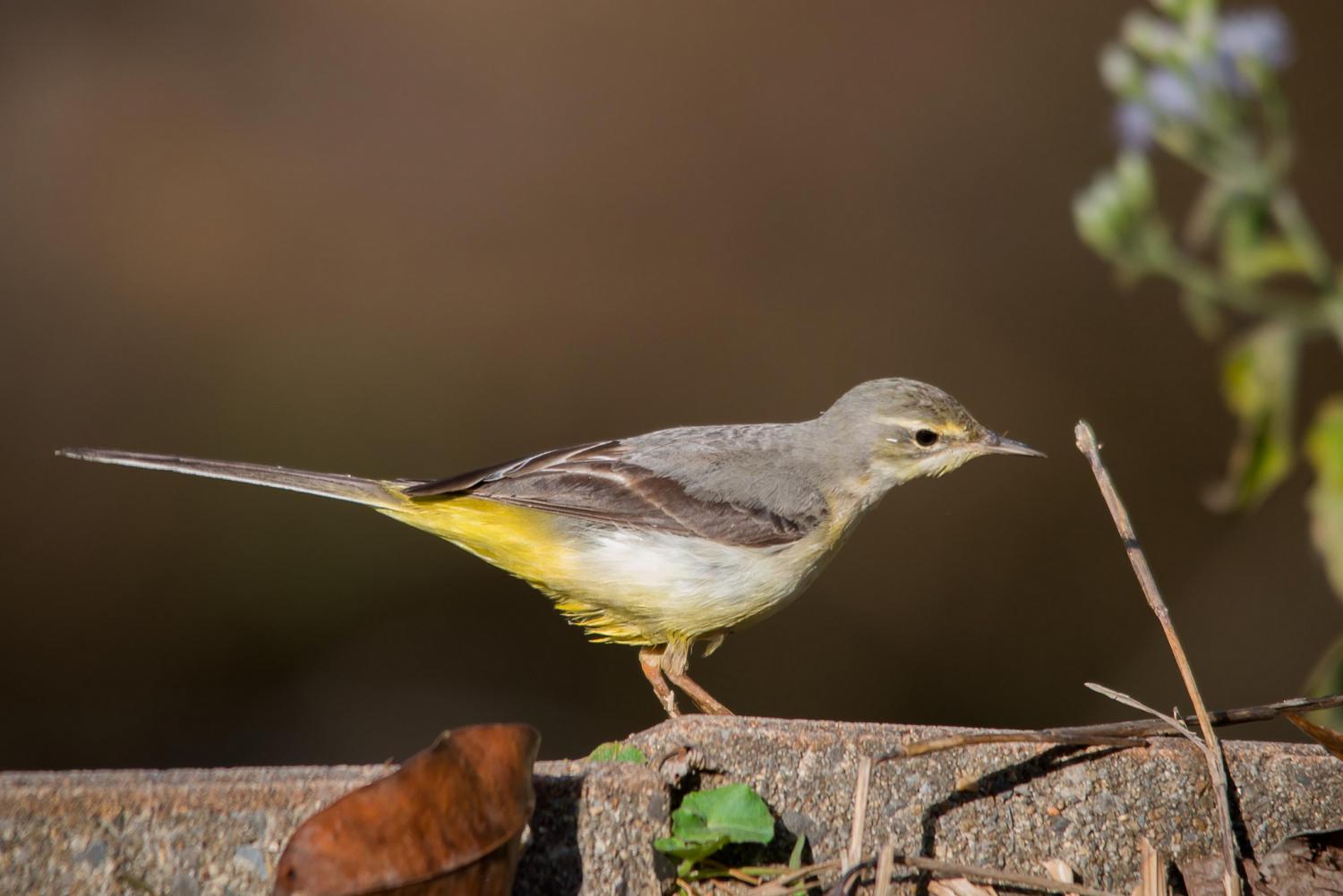Species of Thailand
Grey wagtail
Motacilla cinerea
Marmaduke Tunstall, 1771
In Thai: นกเด้าลมหลังเทา
The grey wagtail (Motacilla cinerea) is a member of the wagtail family, Motacillidae, measuring around 18–19 cm overall length. The species looks somewhat similar to the yellow wagtail but has the yellow on its underside restricted to the throat and vent. Breeding males have a black throat. The species is widely distributed, with several populations breeding in Eurosiberia and migrating to tropical regions in Asia and Africa. The species is always associated with running water when breeding, although they may use man-made structures near streams for the nest. Outside the breeding season, they may also be seen around lakes, coasts and other watery habitats. Like other wagtails, they frequently wag their tail and fly low with undulations and they have a sharp call that is often given in flight.
Taxonomy and systematics
The binomial name of the grey wagtail Motacilla cinerea was introduced by Marmaduke Tunstall in his 1771 publication Ornithologia Britannica. Motacilla is the Latin name for the pied wagtail; although actually a diminutive of motare, "to move about", from medieval times it led to the misunderstanding of cilla as "tail". The specific cinerea is Latin for "ash-grey" from cinis, "ashes".
The relationships of this species are not well resolved; it belongs to the non-African clade of wagtails, these are confusing in their external morphology, and mtDNA cytochrome b and NADH dehydrogenase subunit 2 sequence data are not able to robustly resolve their relationships. While the present species is probably most closely related to citrine wagtails and some blue-headed wagtails, the exact nature of this relationship is unclear.
Description
This slim wagtail has a narrow white supercilium and a broken eye ring. The upperparts are grey and the yellow vent contrasting with whitish underparts makes it distinctive. The breeding male has a black throat that is edged by whitish moustachial stripes. They forage singly or in pairs on meadows or on shallow water marshes. They also use rocks in water and will often perch on trees. They have a clear sharp call note and the song consists of trills.
Distribution and habitat
The bird is widely distributed across the Palearctic region with several well marked populations. The nominate form (includes caspica of Iran, Turkey and the Caucasus) is from western Europe including the British Isles, Scandinavia and Mediterranean region. Race melanope, which is not well separated from the nominate subspecies, is described as the population breeding in eastern Europe and central Asia mainly along the mountain chains of the Urals, Tien Shan and along the Himalayas. They winter in Africa and Asia. Race robusta breeds along the northeastern parts of Asia in Siberia extending to Korea and Japan. These winter in Southeast Asia. Island forms include patriciae of the Azores, schmitzi of Madeira and canariensis of the Canary Islands.
They sometimes occur on the islands to the West of Alaska but have been known to occur further south in California as a vagrant.
Behaviour and ecology
The breeding season is April to July and the nest is placed near fast running streams or rivers on an embankment between stones and roots. The male in display, makes short flights up into the air and descends slowly with fluttering flight accompanied by a rapid series of chipping high notes. In Europe the nests are often made in holes in manmade structures. The clutch consists of 3–6 speckled eggs and multiple broods may be raised with declining numbers in the clutch in subsequent broods. The usual clutch size is five in Ireland and the breeding success is about 80% with predation of eggs or chicks being the main cause of breeding failure. The Canary Islands population typically have smaller clutches and the breeding season is not as short and well marked as in populations at higher latitudes. The incubation period is about two weeks with chicks fledging within a fortnight. They live for a maximum of 8 years in the wild.In some parts of its range the white-throated dipper nests in the same habitats as the grey wagtail and there are some records of interspecific feeding of dipper chicks by adult wagtails.
These birds feed on a variety of aquatic invertebrates including adult flies, mayflies, beetles, crustacea and molluscs. They often forage along roadsides in winter, flushing with a sharp chi-cheep call and flying up further along the road but after some distance turning back to return to the original location.
In winter, they roost in small groups. Wintering birds have been known to return to the same sites, sometimes a small urban garden, each year.
Adults often have parasitic ticks, Ixodes ricinus, which can harbour Borrelia and thus can potentially disperse Lyme disease over a wide region. Coccidia such as Isospora sp. are known in this species. The common cuckoo is sometimes a brood parasite of this species, and kestrels may sometimes prey on them.
This article uses material from Wikipedia released under the Creative Commons Attribution-Share-Alike Licence 3.0. Eventual photos shown in this page may or may not be from Wikipedia, please see the license details for photos in photo by-lines.
Category / Seasonal Status
Wiki listed status (concerning Thai population): Winter visitor
BCST Category: Recorded in an apparently wild state within the last 50 years
BCST Seasonal status: Non-breeding visitor
Scientific classification
- Kingdom
- Animalia
- Phylum
- Chordata
- Class
- Aves
- Order
- Passeriformes
- Family
- Motacillidae
- Genus
- Motacilla
- Species
- Motacilla cinerea
Common names
- Thai: นกเด้าลมหลังเทา
Synonyms
- Calobates melanope
- Motacilla melanope
Conservation status

Least Concern (IUCN3.1)
Photos
Please help us review the bird photos if wrong ones are used. We can be reached via our contact us page.
Range Map

- Ao Manao-Khao Tanyong National Park
- Ao Phang-Nga National Park
- Ban Bueng District, Chonburi
- Bang Lamung District, Chonburi
- Bang Lang National Park
- Bang Phra Non-Hunting Area
- Bang Pu Recreation Centre
- Bang Saphan Noi District, Prachuap Khiri Khan
- Bangkok Province
- Bueng Boraped Non-Hunting Area
- Chae Son National Park
- Chaloem Phrakiat Thai Prachan National Park
- Chat Trakan Waterfall National Park
- Chiang Dao District, Chiang Mai
- Chiang Dao Wildlife Sanctuary
- Chiang Khong District, Chiang Rai
- Chiang Saen District, Chiang Rai
- Dan Chang District, Suphan Buri
- Doi Chong National Park
- Doi Inthanon National Park
- Doi Lang
- Doi Lo District, Chiang Mai
- Doi Pha Hom Pok National Park
- Doi Phu Kha National Park
- Doi Saket District, Chiang Mai
- Doi Suthep - Pui National Park
- Erawan National Park
- Fang District, Chiang Mai
- Hala-Bala Wildlife Sanctuary
- Huai Kha Khaeng Wildlife Sanctuary
- Huai Nam Dang National Park
- Kaeng Khoi District, Saraburi
- Kaeng Krachan National Park
- Kaeng Krung National Park
- Kaeng Som Maew Queen Sirikit Forest Park
- Kanthararom District, Sisaket
- Kaset Sombun District, Chaiyaphum
- Khao Ang Rue Nai Wildlife Sanctuary
- Khao Banthat Wildlife Sanctuary
- Khao Chong
- Khao Khitchakut National Park
- Khao Laem National Park
- Khao Laem Ya - Mu Ko Samet National Park
- Khao Lak - Lam Ru National Park
- Khao Luang National Park
- Khao Nam Khang National Park
- Khao Nan National Park
- Khao Phanom Bencha National Park
- Khao Phra - Bang Khram Wildlife Sanctuary
- Khao Phra Thaeo Wildlife Sanctuary
- Khao Sam Roi Yot National Park
- Khao Soi Dao Wildlife Sanctuary
- Khao Sok National Park
- Khao Yai National Park
- Khao Yoi District, Phetchaburi
- Khlong Lan National Park
- Khlong Nakha Wildlife Sanctuary
- Khlong Phanom National Park
- Khlong Saeng Wildlife Sanctuary
- Khon San District, Chaiyaphum
- Khun Chae National Park
- Khun Korn Forest Park
- Khun Nan National Park
- Khun Tan District, Chiang Rai
- Khura Buri District, Phang Nga
- Klaeng District, Rayong
- Ko Chang National Park
- Ko Lanta National Park
- Ko Samui District, Surat Thani
- Ko Tao
- Kui Buri National Park
- Kumphawapi District, Udon Thani
- Laem Pak Bia
- Lam Nam Kok National Park
- Lan Sang National Park
- Mae Ai District, Chiang Mai
- Mae Chan District, Chiang Rai
- Mae Fa Luang District, Chiang Rai
- Mae Moei National Park
- Mae Ngao National Park
- Mae Ping National Park
- Mae Rim District, Chiang Mai
- Mae Sot District, Tak
- Mae Taeng District, Chiang Mai
- Mae Wong National Park
- Mu Ko Phetra National Park
- Muak Lek District, Saraburi
- Mueang Chiang Mai District, Chiang Mai
- Mueang Chumphon District, Chumphon
- Mueang Kalasin District, Kalasin
- Mueang Kanchanaburi District, Kanchanaburi
- Mueang Khon Kaen District, Khon Kaen
- Mueang Krabi District, Krabi
- Mueang Lamphun District, Lamphun
- Mueang Nakhon Nayok District, Nakhon Nayok
- Mueang Pattani District, Pattani
- Mueang Phang Nga District, Phang Nga
- Mueang Phetchaburi District, Phetchaburi
- Mueang Phuket District, Phuket
- Mueang Samut Sakhon District, Samut Sakhon
- Mueang Samut Songkhram District, Samut Songkhram
- Mueang Sukhothai District, Sukhothai
- Mueang Suphanburi District, Suphan Buri
- Mueang Tak District, Tak
- Nam Nao National Park
- Namtok Phlio National Park
- Namtok Sam Lan National Park
- Nong Ya Plong District, Phetchaburi
- Omkoi Wildlife Sanctuary
- Op Khan National Park
- Pai District, Mae Hong Son
- Pak Phli District, Nakhon Nayok
- Pak Thale
- Pang Sida National Park
- Pha Daeng National Park
- Pha Taem National Park
- Phan District, Chiang Rai
- Phu Chi Fa Forest Park
- Phu Chong Na Yoi National Park
- Phu Foi Lom National Park
- Phu Hin Rong Kla National Park
- Phu Khiao Wildlife Sanctuary
- Phu Kradueng National Park
- Phu Langka National Park
- Phu Luang Wildlife Sanctuary
- Phu Pha Thoep National Park
- Phu Soi Dao National Park
- Phu Suan Sai National Park
- Phu Toei National Park
- Phu Wiang National Park
- Pran Buri Forest Park
- Sai Yok District, Kanchanaburi
- Sai Yok National Park
- Sakaerat Environmental Research Station
- Samae San Island
- Samut Prakan Province
- San Kala Khiri National Park
- Sanam Bin Reservoir Non-Hunting Area
- Sangkhla Buri District, Kanchanaburi
- Similan Islands
- Sirinat National Park
- Sri Nakarin Dam National Park
- Sri Phang Nga National Park
- Sukhirin District, Narathiwat
- Surin Islands
- Tai Rom Yen National Park
- Takua Pa District, Phang Nga
- Tarutao National Marine Park
- Tat Mok National Park
- Tat Ton National Park
- Tha Yang District, Phetchaburi
- Thai Mueang District, Phang Nga
- Thalang District, Phuket
- Thale Ban National Park
- Thale Noi Non-Hunting Area
- Tham Sakoen National Park
- Thanyaburi District, Pathum Thani
- Thap Lan National Park
- Thong Pha Phum National Park
- Thung Salaeng Luang National Park
- Thung Yai Naresuan Wildlife Sanctuary
- Ton Nga-Chang Wildlife Sanctuary
- Umphang Wildlife Sanctuary
- Wang Chan District, Rayong
- Wang Mai Forest Restoration Project
- Wiang Kaen District, Chiang Rai



